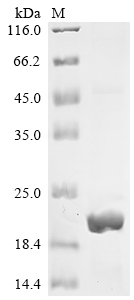Amino acids 408-534 constitute the expression domain of recombinant Human SPAG9. The expected molecular weight for the SPAG9 protein is calculated to be 20.0 kDa. The SPAG9 protein was expressed in e.coli. The SPAG9 coding gene included the N-terminal 10xHis tag and C-terminal Myc tag, which simplifies the detection and purification processes of the recombinant SPAG9 protein in following stages of expression and purification.
C-Jun-amino-terminal kinase-interacting protein 4 (SPAG9) is known to interact with c-Jun N-terminal kinase (JNK), a key component of the mitogen-activated protein kinase (MAPK) signaling pathway. This interaction suggests a role for SPAG9 in mediating cellular responses to extracellular signals, including those related to cell growth, differentiation, and apoptosis. Additionally, SPAG9 has been implicated in the regulation of microtubule dynamics, contributing to cell migration and invasion. Its overexpression has been observed in certain cancers, suggesting a potential role in tumorigenesis.






